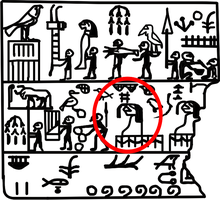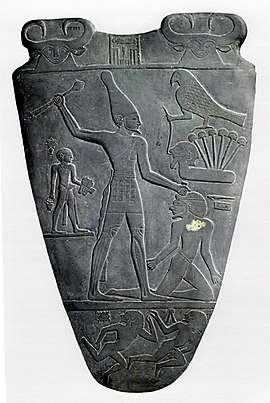Penebui
Penebui was an early Egyptian queen and most possibly the wife of king Djer during the 1st dynasty. Her name was found engraved on several ivory tags.
| Penebui in hieroglyphs | ||||
|---|---|---|---|---|
Pe-nebui (personal name) P.nb.wj Seat of the Two Lords | ||||
Weret-hetes (royal title) Wr.t hts Great of Hetes-Scepters | ||||

Identity
There are at least three ivory tags showing queen Penebui. Two were found in the necropolis of king Djer at Abydos, one (pretty damaged) at Saqqara in an anonymous tomb. The tags, called year tablets, show depictions of several ceremonies, such as a human sacrifice and the presentation of several cultic objects. The center of the engraving shows two figures of deceased queens. They are shown in shape of busts with female heads and hair styles, resting on palacial decorated pedestals. There are fountains of blood coming out of their foreheads, symbolising the death of the women. In earlier times this blood fountains were falsely interpreted as flower ornaments or snake diadems. Both ladies names are introduced by a rare hieroglyph similar to the later sign for "excrement", the signs on the labels simply mean "to die" or "death". The former, first depicted lady can be identified as queen Penebui, this name means "seat of the two lords". Her name is also guided by the title Weret-hetes, meaning "great one of the Hetes scepetre", identifying her as a royal spouse. The other lady on the tags must have also been a queen, but of lower rank. Her title was Ma'a-heru, meaning "she who sees Horus". Unfortunately, her name is very difficult to read, it might be written with three fish symbols.[1][2]
Penebui's death seems to be recorded on the famous Palermo stone in the 4th year event window of king Djer. Wolfgang Helck suspects that queen Penebui died violently due decapitation, since the sign of a deceased royal lady in the year window is guided by the hieroglyph of an decapitated lapwing.[1]
References
- Wolfgang Helck: Untersuchungen zur Thinitenzeit (= Ägyptologische Abhandlungen. Bd. 45). Harrassowitz, Wiesbaden 1987, ISBN 3-447-02677-4, p. 119 & 154.
- Wolfram Grajetzki: Ancient Egyptian Queens A Hieroglyphic Dictionary. Golden House Publications, London 2005, ISBN 9780954721893, p. 65.
